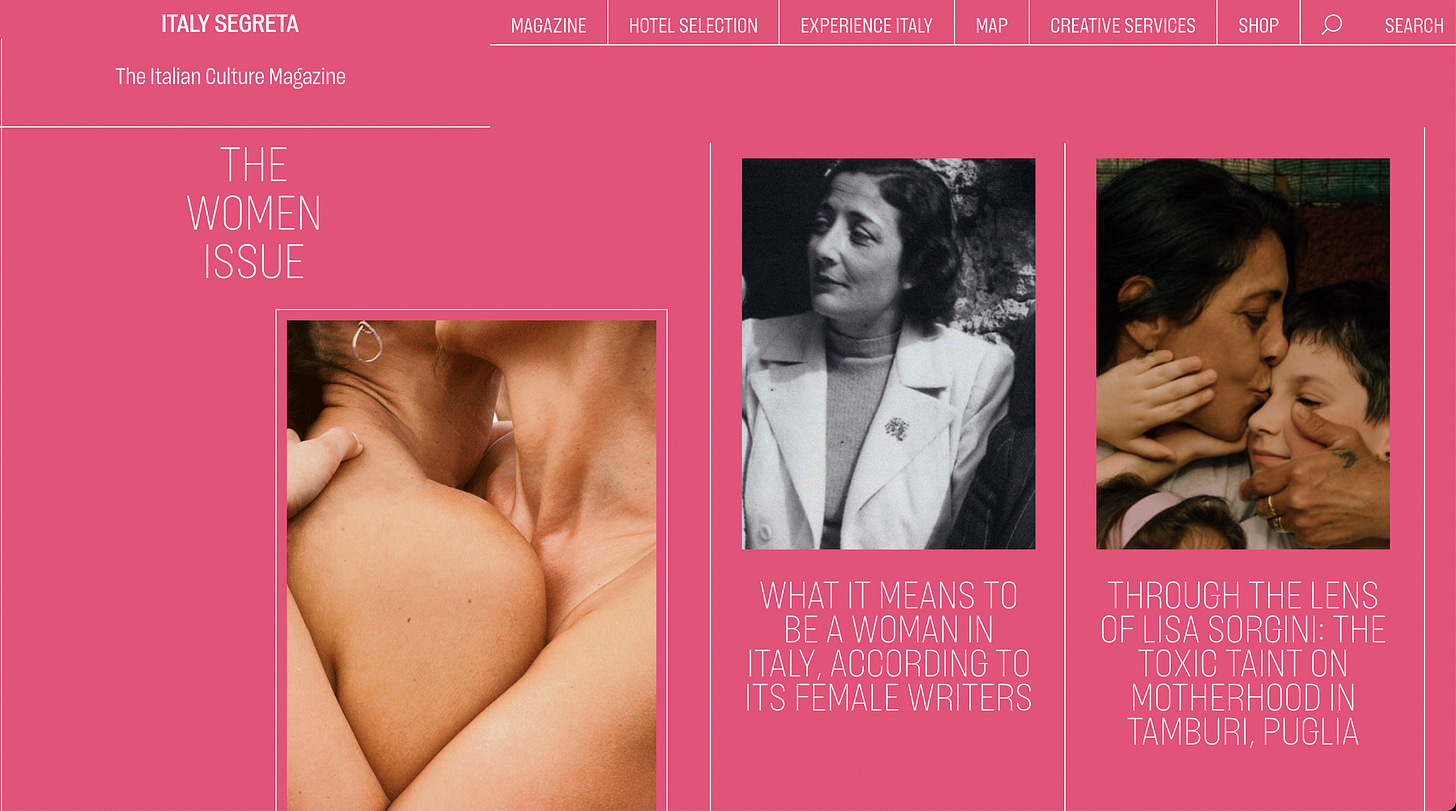Hyper-tourism… in Abruzzo?
Plus, dietary polemics and a physicist’s take on Botticelli’s Primavera
Over the past few weeks some truly extraordinary stories have been coming out of rural Abruzzo, the sparsely populated mountainous region just east of Rome. It all began on 25 January when Rita de Crescenzo, a Neapolitan influencer, posted videos of herself on her TikTok channel parading through snowy fields just outside the small town of Roccaraso in the southern Apennines. Wandering around the niveous slopes, she declared the landscape “bello, bello, bello!” before imploring her 1.5 million followers “to come here now, everyone!” This is pretty standard social media content, I know. What’s less standard, however, is that people actually took the influencer at her word. Last week, two hundred buses and several hundred cars descended on Roccaraso, a village with a resident population of just 1500. Tourists blocked the roads, filled up the squares, and left huge amounts of litter behind. The mayor was forced to mobilize emergency resources to manage the traffic, to ensure public safety, and even considered bringing the army in! This is an extraordinary story. Obviously, it’s a fascinating example of how much power influencers wield in today’s world. But there are other angles too. Take climate change. Would so many have flocked to this small village if snow had not, over the past decades, become such a rare sight in the South of Italy? Probably not. And what about the role of tour companies? Could such huge crowds have moved so quickly if it weren’t for 30 euro day trip bus fares? The answer is no. The fact is, Italy’s tourist industry is intimately linked to broader socio-economic incentives. As the researcher Sarah Gainsforth put it on today’s Internazionale podcast, “these small villages are all trying to get tourists and few of them succeed. The irony is, when they do so, it looks like Roccaraso.” Indeed. At the time of writing Rita di Crescenzo has left Roccaraso, and the crowds have started to die down. The influencer, however, is unapologetic about her role in the debacle and has since offered a new command to her followers: "Andiamo a Ovindoli" [Next stop, Ovindoli!]

“The Mediterranean diet is a lie!” This, at least, is the title of a provocative new essay by Alessandro Ford which POLITICO magazine published earlier this week. The gist, as you’d imagine from that title, is as follows. According to Ford, the Mediterranean diet is a fictional invention which American nutritionists conjured up in the postwar period to present U.S citizens with a healthier counterpoint to their own notoriously unbalanced cuisine. In order to do this, scientists manipulated a few studies and exaggerated the virtues of southern European eating habits while ignoring regional discrepancies in diet and, above all, the problem of food scarcity. The Italians, for their part, embraced the fiction and state actors propagandized the same story to the world even as the country’s children began to fill up on the same processed foods, sugar and salts as most Americans. None of this is exactly wrong. But it’s not exactly news either. John Dickie covered most of these points in more detail in his book Delizia! The Epic History of the Italians and Their Food and he’s (rightly) quoted here. Ford is also a bit cheeky with some of his framing, by, for example, conflating the Italian and Mediterranean diets. If you’re patient enough to excuse the bombastic rhetoric, however, you’ll find that this is a well-researched article which provides some important myth-busting about Italy’s sometimes over-romanticised food culture. So here’s the link [to take with a pinch of salt.]

Italy Segreta’s latest edition - “the women issue” - is now online, and it’s got two excellent photography pieces that I think will interest readers here. First, you’re going to want to have a flick through this interesting piece by Deborah D’Addetta in which she profiles 11 female photographers, most of whom are Italian, and all of whom, in their own ways, are exploring the creative female gaze at work in the country. It would be hard to pick highlights but I came away particularly interested in learning more about the work of Serena Russo, who composes fabulously melancholic, black and white female profiles, Ilaria Toma, who has created some amazing surreal(ist) compositions, Maria Flaminia Bari, who specialises, among other things, in punk-like nudes, and Lavinia Cernau, who has shot some beautifully hedonistic, golden hour summer pictures. While you’re at it, I’d also recommend taking a look at Alexia Petsinis and Lisa Sorgini’s photojournalism essay which explores how pollution from the steel plant in Taranto has impacted on ideas about motherhood and on the health of mothers and children in the Puglian town. Check out the full issue here.
Arts and culture: Rites of Spring
Last week the theoretical physicist Howard Burton released a new feature length documentary in which he takes an unorthodox and interdisciplinary approach to decoding the mysterious symbolism of Sandro Botticelli’s 15th Century painting, the Primavera. Burton is not your usual art history presenter. In fact, he has no formal background in the discipline at all! Instead, he uses his professional skillset, and ‘scientific’ gaze, to walk the reader through the core motifs and characters of the painting but also to dwell on its small - even “quantum” - details. If this sounds overwhelming, overly technical or just plain inaccessible, don’t fret. Burton is charmingly erudite and he’s as well versed in classical mythology as he is in string theory. He’s also a skilled communicator, and his main mission here is to help lay audiences around the world become more attuned to the secrets of Botticelli’s wonderful artwork. There is, undeniably, a whiff of the high school lecture hall to this film, and it does feel at times like a glorified PowerPoint presentation. But these issues are forgivable. The content itself is fascinating, and, at just 1hr running time, it’s well worth checking out. Stream the film on Ideas Roadshow or Prime Video if you’re interested.
Unless you’re a millenial-zoomer TikTok addict you’ve probably never heard of ‘Sabina’, one of Italy’s biggest young social media stars. I, for one, was completely oblivious about her work, and the popularity of her work, until a friend recommended her podcast ‘Il fatto Delle Sabine’ to me this week. And you know what? It’s actually pretty good! Sabina launched her show last year as an outlet for expressing her takes on a wide variety of social and cultural issues. Every weekday morning, the comedy-influencer releases a new 10-minute episode in which she offers her thoughts about a famous figure in pop culture (Justin Timberlake, Nicholas Cage), cinema (David Lynch), philosophy and literature (Simone De Beauvoir) and even classical history (Settimo Severo). ‘How can one person tackle all this?,’ you might be thinking, ‘and how can it be any good?’ The answer is simple: Sabina’s approach is unashamedly postmodern. She’s more concerned with discussing the online discourse around her subjects than the subjects themselves. This is, after all, a comedy show at its core. So if you’re looking to learn something new about the world, to engage with a hyper-contemporary slice of Italian culture, and to have fun while doing it, this might be up your street.
Recipe of the Week: Italian roast chicken with rosemary, anchovy, garlic and lemon butter
Generally speaking, Italians tend to cut chicken into pieces, privileging leg and thigh meat over breast which is generally saved for flash-frying in cutlets. This weekend, however, I found myself possessed by a deep desire to roast a whole bird so I decided to cook up Letitia Clark’s “Kind of Italian Roast Chicken.” And I can honestly say this is one of the best meat dishes I’ve ever prepared. Part of the reason, for sure, can be attributed to the sheer quantity of butter. Clark suggests using 200g, almost an entire stick, which she blends together with anchovies, garlic, rosemary and lemon zest before stuffing it under the skin and placing the rest in the cavity. She also offers extremely precise cooking instructions: she roasts her bird upside down for 40 minutes before flipping it over to brown for 20 minutes. After a short rest, you’re ready to serve. It’s as simple as that. And the result, in my case, was extraordinary. The flavour from the herbs permeated the chicken perfectly, and the meat was perfectly tender and cooked throughout. Delicious! Serve this with bread and a bitter salad and enjoy the leftovers the next day, as she suggests, in a panino with sundried tomato mayo. Here’s the link [note: scroll halfway down the blog for her chicken instructions, and click here to read about her suggested next-day sandwich!].

I’m Jamie Mackay, a UK-born, Italy-based writer, working at the interfaces of journalism, criticism, poetry, fiction, philosophy, travelogue and cultural-history. I set up ‘The Week in Italy’ to make a space to share a regular overview of the debates and dilemmas, innovations and crises that sometimes pass under the radar of our overcrowded news feeds, to explore politics, current affairs, books, arts and food. If you’re a regular reader, and you enjoy these updates, I hope you’ll consider becoming a supporter for EUR 5.00 per month. I like to think of it as a weekly catch-up chat over an espresso. Alternatively, if you’d like to send a one-off something, you can do so via PayPal using this link. Grazie!




